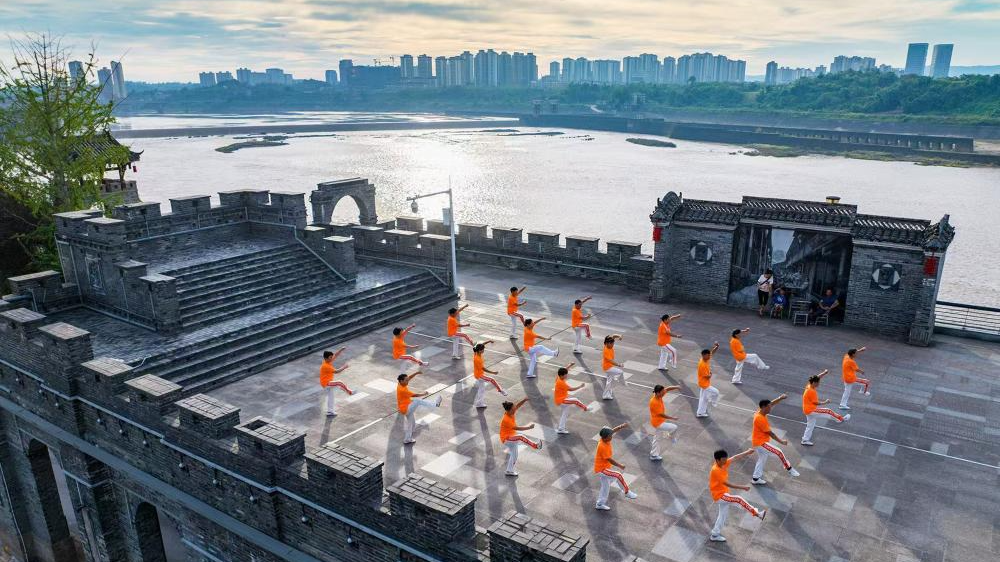Pairing-up aid to Xizang bearing fruit
Liu Haixia, a doctor from the critical care medicine department of Beijing Youan Hospital, said she is proud to be one of the medical experts from other parts of China who have gone to aid hospitals in the Xizang autonomous region, because they have made a difference that has saved lives.

Photo taken on March 12, 2021, shows the Potala Palace in Lhasa, the capital of Southwest China's Xizang autonomous region. (Photo/Xinhua)
Liu was among the 21 medical experts from hospitals in Beijing who went to assist the People's Hospital of Lhasa in 2021.
Since August 2015, teams of medical experts from a number of different fields have been sent by provinces and cities to raise the overall level of healthcare offered by hospitals in Xizang.
Liu said that this model, in which the teams of experts are paired with specific hospitals, allows doctors from different departments to work together to introduce new medical technology, conduct complicated operations, and improve the training of doctors in Xizang.
"The local people really trust us. And they now can have many diseases treated on their doorstep, which is in fact lifesaving," said Liu, who spent a year at the hospital in Lhasa, the regional capital.
Nyima, deputy director of the People's Hospital of Lhasa, said that in 2015 it only had 240 beds available but the number has now reached 550, adding that the number of operations performed at the hospital in 2023 had more than doubled compared with 2015.
"Thanks to the doctors from Beijing who come to assist us, we can now perform more complicated operations and treat patients with complicated diseases. Their continuous support also means that the local people are able to receive quality and convenient healthcare services all the time," Nyima said.
Improving Xizang's healthcare system is only one aspect that the pairing-up assistance program aims to achieve. The program, which has been carried out for 30 years, has tremendously promoted the region's social and economic development and significantly improved the lives of local residents, according to people involved in the program.
In 1994, the central government made a strategic decision to rally national support for Xizang. Under the policy of pairing-up assistance for the region, 17 provinces and cities as well as 78 central State organs and 27 centrally administered State-owned enterprises are designated to assist in specific areas of Xizang, injecting strong impetus into the development of the plateau region.
Since the 18th National Congress of the Communist Party of China in 2012, an unprecedented amount of funds and personnel have been earmarked for the pairing assistance work, covering an unprecedentedly wide range of areas.
In addition, the program has been further improved to focus on solving the most pressing difficulties and problems that are of great concern to the people. As a result, the updated pairing-up assistance model for healthcare was introduced in 2015, and that for education in 2016.
In addition, to aid Xizang's rural vitalization drive, 80 percent of the pairing-up assistance funding is required to be used to improve people's livelihoods and support the development of rural areas, so that more benefits can be directly delivered to a wider range of people on a long-term basis.
At the seventh Central Symposium on Xizang Work, which was held in Beijing in August 2020, President Xi Jinping stressed a long-term commitment to the CPC Central Committee's policy to ensure that Xizang has support from the central authorities and assistance from the whole country. Achieving sustained stability and rapid development in Xizang constitutes a major contribution to the overall work of the Party and State, he added.
During his visit to Xizang in July 2021, Xi, who is also general secretary of the CPC Central Committee and chairman of the Central Military Commission, said that the spirit of assisting Xizang is highly valued by the CPC and represents a significant advantage of socialism with Chinese characteristics.
During the trip, when meeting personnel who came to assist the region's development in different sectors, Xi said that these efforts to aid Xizang must be carried on from one group of talented personnel to another, and from one generation to another.
While skills and strength have been pooled to support the region's development, such experiences have also put people's competence to the test, he said, adding that the experience of providing assistance to Xizang should be cherished.
Almost 12,000 personnel in 10 groups have been sent to Xizang since the pairing-up assistance program was initiated 30 years ago, said Song Liqiang, deputy head of the organization department of the regional Party committee.
Over the past three decades, the number of personnel selected to assist Xizang's development has increased steadily, from 622 in the first group to 2,117 in the 10th group, Song said during a news conference on Thursday.
The composition of these groups, consisting of professionals, technicians, government officials, and enterprise managers, has been increasingly optimized over the years in terms of gender, educational background, age, and professional structure, Song added.
"Their involvement has boosted the high-quality development of Xizang and enhanced exchanges and communication among people from all ethnic groups. They have also played a key role in mentoring local officials and personnel in different sectors," Song said.
Meanwhile, nearly 2,000 medical experts from 184 hospitals nationwide have assisted in the development of healthcare services in Xizang since August 2015, the regional health commission said last week.
"They have made an obvious and huge difference by helping the region to improve its standard of healthcare, which has benefited everyone in Xizang," said Nyima from the People's Hospital of Lhasa.
Currently, the maternal mortality rate in the region is 38.63 per 100,000 people, the infant mortality rate is 5.37 per 1,000, the hospital delivery rate is 99.15 percent, and the average life expectancy is 72.19 years. All of these indicators are at the best levels in Xizang's history, Song said.
Photos
Related Stories
- Expedition shows Xizang's improving biodiversity
- Tibetan opera performances staged in Lhasa to celebrate traditional Shoton Festival
- China urges U.S. to honor commitments concerning Xizang-related issues
- China's Xizang introduces novel research model for dairy cows
- Nearly 12,000 talents assist Xizang's development over 30 years
- Picturesque night scenery of Nyingchi in Xizang
Copyright © 2024 People's Daily Online. All Rights Reserved.









